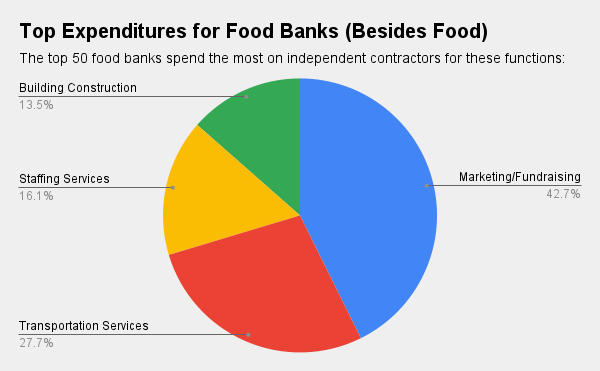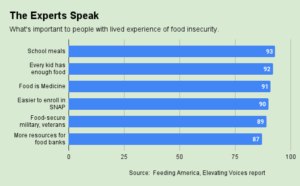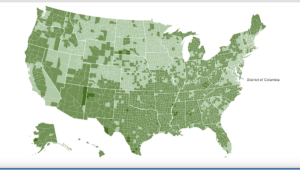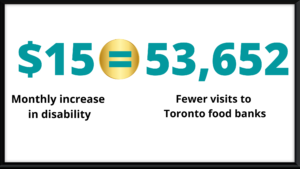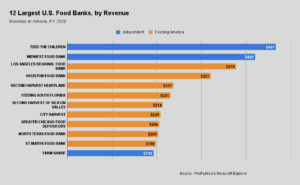It’s fair to say that the biggest expenditure in a food bank’s budget is food, especially now, as ongoing demand continues to outstrip the amount of food coming in via donations and federal aid. But there are plenty of other things that food banks spend money on to keep their operations going.
One window into these expenditures comes from the tax returns that nonprofits file. Specifically, Part VII, Section B of food banks’ Form 990 annual filings (many of them can be found here) ask food banks to list their five most highly compensated independent contractors receiving more than $100,000 a year.
In looking at the most recently filed Form 990s of the top 50 food banks (i.e. those with the most revenue), Food Bank News uncovered clear trends regarding the expenses that food banks face. Their top contracted expenditures, as per the 990 filings, are marketing/fundraising, transportation services, staffing services, and building construction.
This summary of expenditures is not the final word on how food banks allocate their budgets. In fact, 11 of the top 50 food banks did not even fill out this section of the Form 990. Even so, the findings offer clear directional information, providing useful (or at least interesting) guidance for food banks making budgeting decisions.
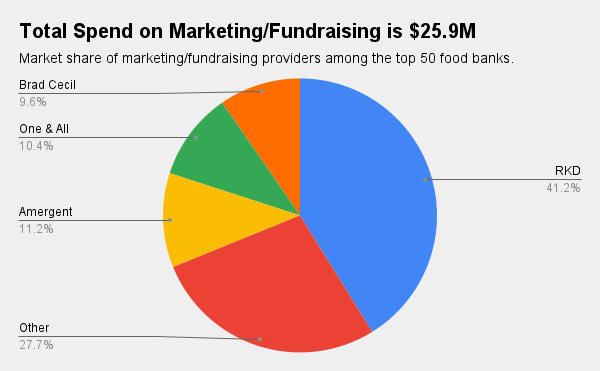 By far, the biggest contracting expenditure is for marketing and fundraising, including services such as direct mail, printing, online giving, database management/analytics, and advertising. In all, the top 50 food banks spent more than $25.9 million on marketing and fundraising services. Eleven food banks spent more than $1 million, with more than half of those coming in at just above $1 million. One outlier spent almost $3 million.
By far, the biggest contracting expenditure is for marketing and fundraising, including services such as direct mail, printing, online giving, database management/analytics, and advertising. In all, the top 50 food banks spent more than $25.9 million on marketing and fundraising services. Eleven food banks spent more than $1 million, with more than half of those coming in at just above $1 million. One outlier spent almost $3 million.
Within this category, one vendor – RKD Group – kept popping up again and again. Just over 40% of the amount spent on marketing and fundraising, or nearly $11 million, went to RKD, a privately held, Dallas-based company that has been in business for more than 40 years. RKD calls itself the leading provider of marketing and fundraising solutions to nonprofits in North America. Other providers that emerged with a significant share among the top 50 food banks included Amergent of Peabody, Mass., One & All, and Brad Cecil & Associates of Arlington, Tex.
After marketing/fundraising, food banks were next most likely to spend money on transportation services, an amount that totaled $16.8 million. These expenditures included leasing and buying trucks; freight and logistics services; vehicle repair, and truck driver staffing. Six food banks spent more than $1 million on transportation. Of those, three spent around $2 million.
Food banks were next most likely to spend on staffing services, an amount that came to $9.8 million in total. Many food banks that spent in this category spent well under $1 million. Only two spent more than $1 million, including one that was an outlier at $3.3 million.
The final category of hefty spending was on building construction and related expenses, which came to $8.2 million in total. Presumably, these expenditures are one-time and not ongoing. However, they could be considerable for the few food banks that had them, ranging for some from $2 million to $3 million. – Chris Costanzo
Like what you’re reading?
Support Food Bank News